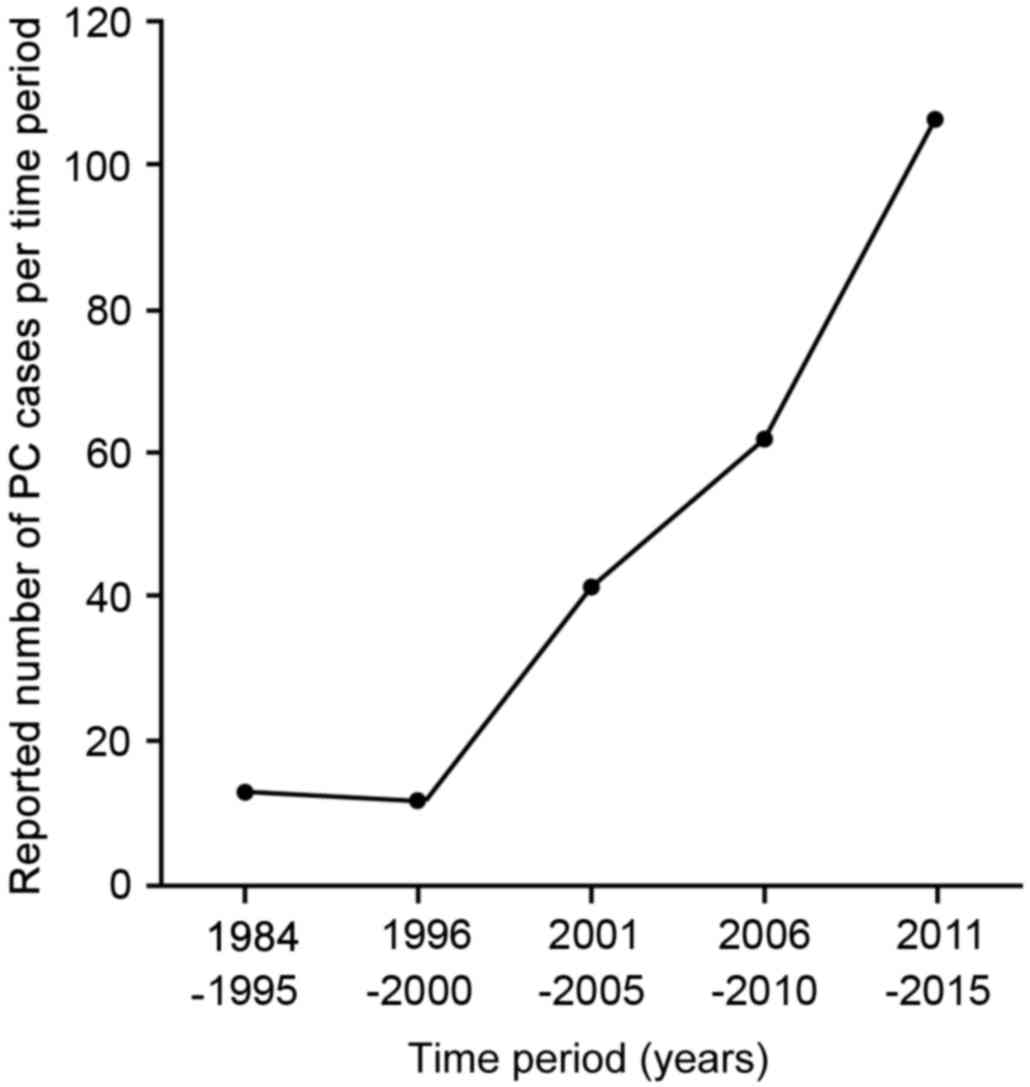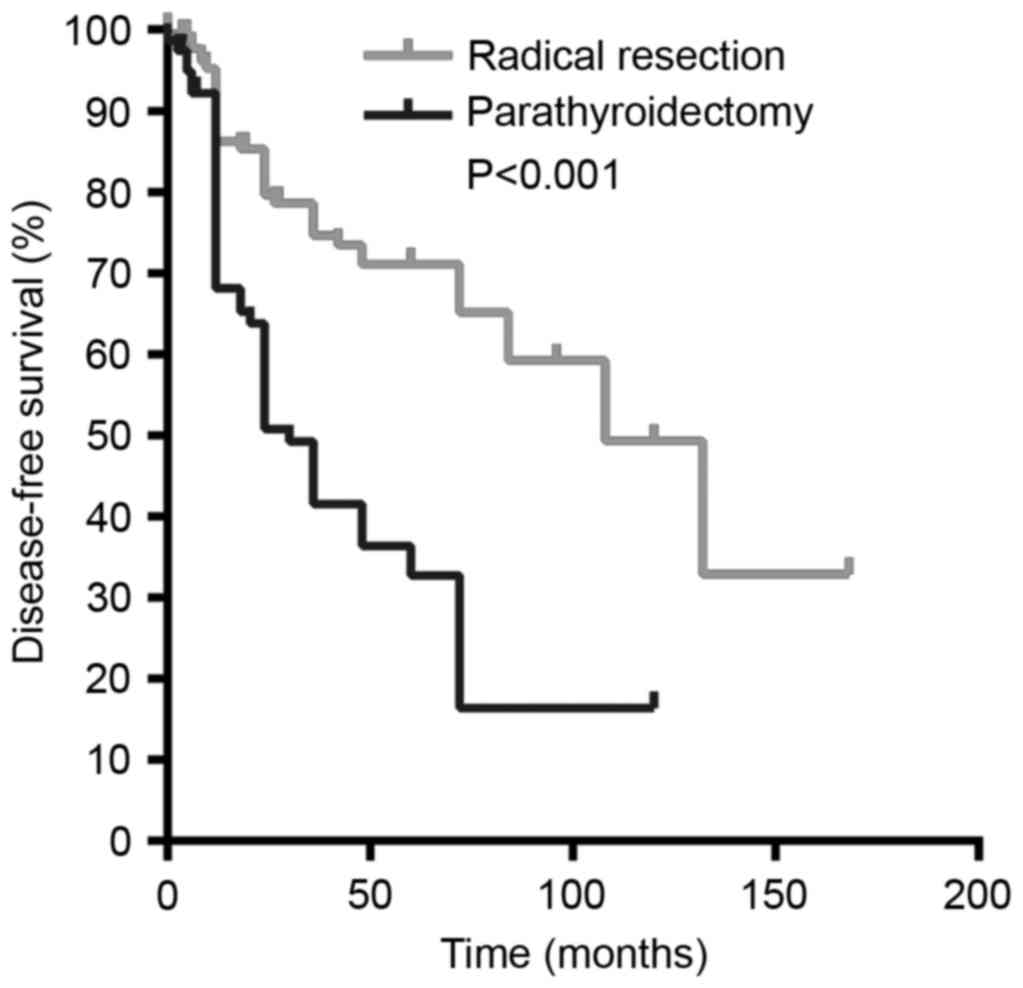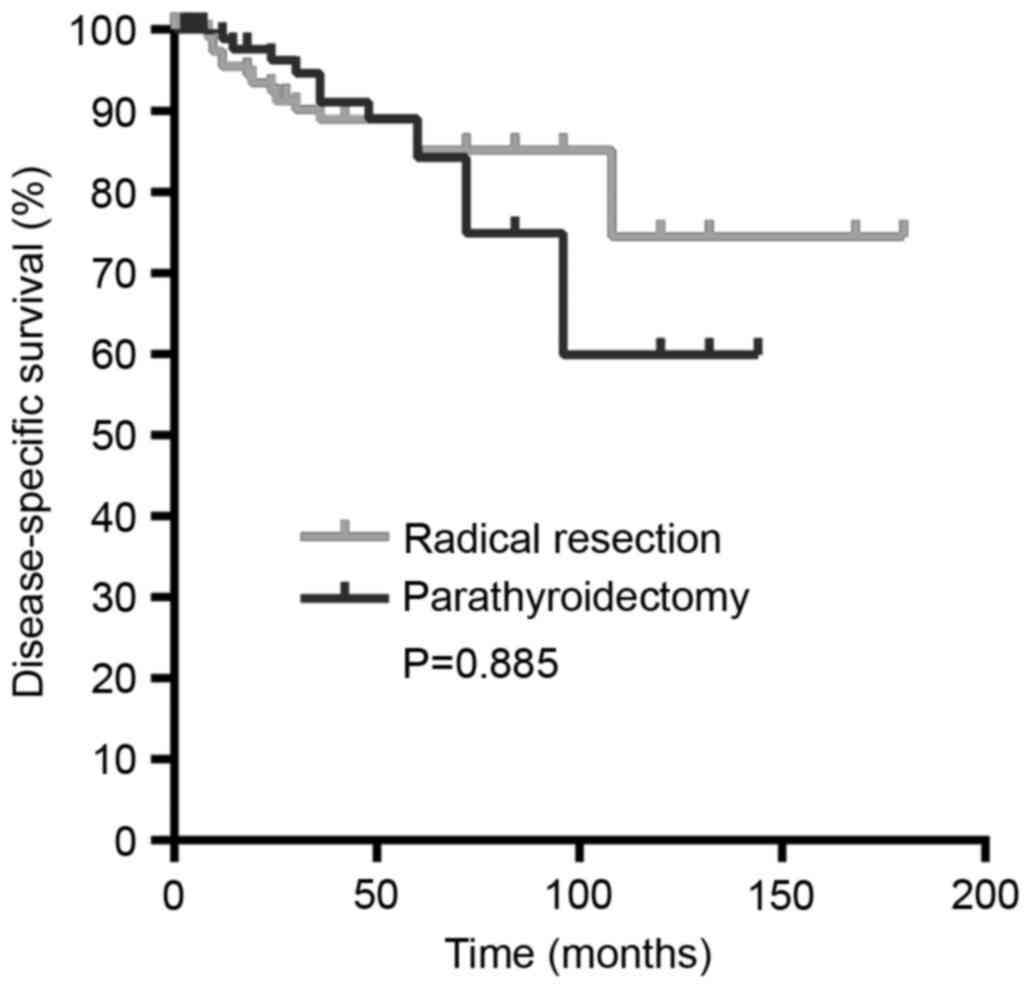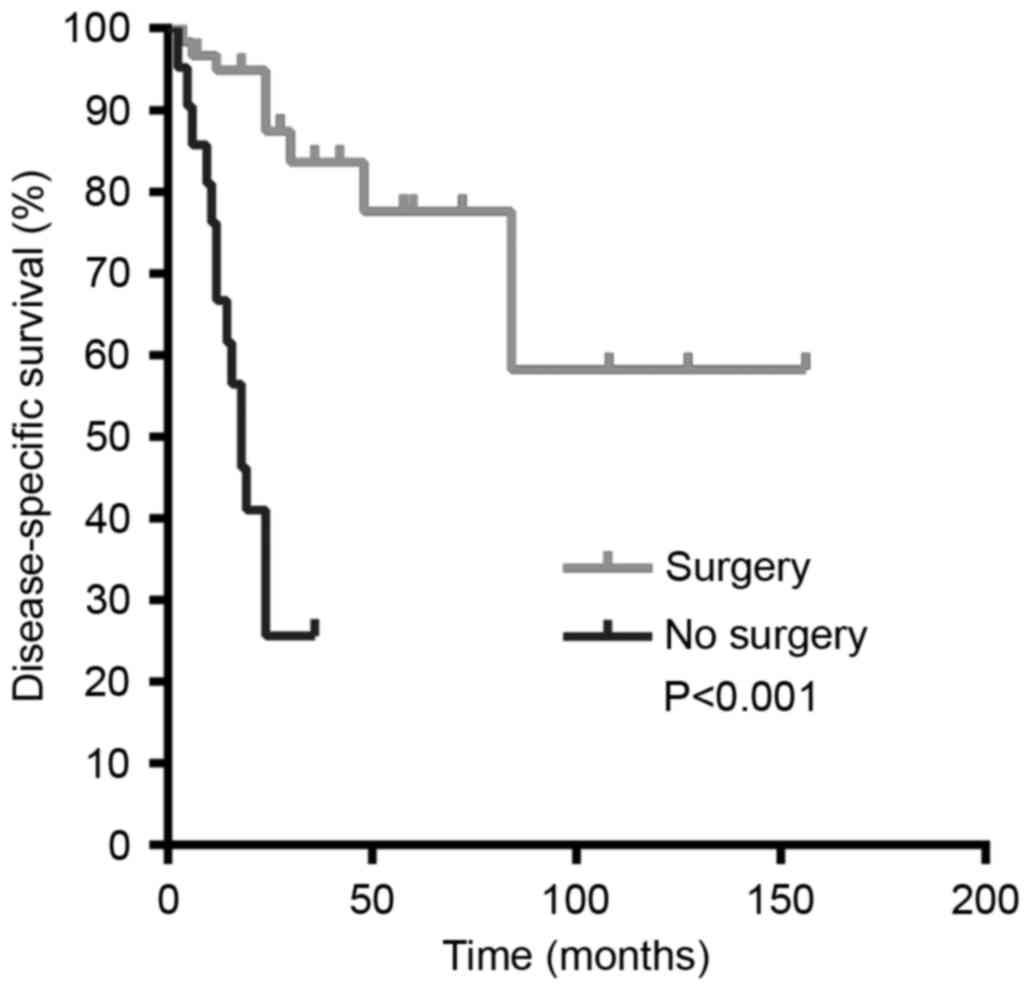Clinical characteristics and treatment outcomes of parathyroid carcinoma: A retrospective review of 234 cases
- Authors:
- Published online on: September 27, 2017 https://doi.org/10.3892/ol.2017.7076
- Pages: 7276-7282
-
Copyright: © Wang et al. This is an open access article distributed under the terms of Creative Commons Attribution License.
Abstract
Introduction
Although parathyroid neoplasms are common and often cause primary hyperparathyroidism (pHPT), parathyroid carcinoma (PC) isa rare endocrine malignancy, and accounts for <1% of cases of pHPT (1). To date, >1,000 cases of PC have been identified in the English literature (2–4); however, there have been no nation-wide large-sample studies in China, and the majority of the available studies are case reports and literature reviews.
The histopathological distinction between benign and malignant parathyroid tumors is often difficult, with up to 50% of patients presenting with metastases following an initial diagnosis of benign disease (5,6). It is of great importance to raise awareness of PC in order to reduce its misdiagnosis and to improve its cure rate and prognosis. In the present study, a systematic review of Chinese language literature on PC was performed, and 8 cases of PC diagnosed and treated at the Department of Thyroid Surgery of The First Hospital of Jilin University (Changchun, China) were included.
As PC is resistant to radiotherapy and chemotherapy, en bloc resection of the tumor is usually recommended; however, there is dispute over whether the prophylactic removal of the ipsilateral central compartment lymph nodes and other regional tissues or organs should be performed (3,6–8). Therefore, clinical evaluation, including preoperative examination and intraoperative judgement by the surgeon, are key factors on which the clinical outcome relies. Adjuvant therapy, including chemo-, radio- or anti-parathyroid hormone (PTH) immunotherapy has also been investigated, but the data are limited (3,7,9–11). Therefore, radical resection remains the standard regimen. For recurrent disease, surgery is also recommended as the primary treatment strategy, and the majority of patients with PC require multiple surgeries (3,7).
Throughout the English literature, >1,000 cases of PC have been identified (2–4). However, a systematic study on a large Chinese cohort is not available, despite the fact that a large number of cases have been described (12–17). Due to a lack of histopathological markers that differentiate malignant from benign parathyroid tumors, up to 50% of patients with metastases have been misdiagnosed initially with benign disease (5,6). Therefore, it is necessary to raise awareness and improve general understanding of PC.
In the present study, 234 cases of PC archived in three commonly used databases in China, or diagnosed and treated in the Department of Thyroid Surgery of The First Hospital of Jilin University, were reviewed in order to summarize the clinicopathological features relevant to the diagnosis and prognosis of this disease, and the current optimal treatment strategy.
Materials and methods
Patient selection
A total of three major databases in China, VIP Journal Integration Platform (qikan.cqvip.com), China Knowledge Resource Integrated Database (www.cnki.net), and Wanfang Data (www.wanfangdata.com.cn), were searched (2 December 2015) using the key words ‘parathyroid cancer’ and ‘parathyroid tumor’. Subsequent to removing duplicate records or those with incomplete information, a final list of archived cases (n=226) from across China, and which contained detailed information, were obtained. These cases were then combined with the 8 cases of PC that had been diagnosed and managed in The First Hospital of Jilin University, and analyzed in the present retrospective study. All cases included in the present study were in one of the following categories: i) Patients who were diagnosed with parathyroid cancer (18) [including patients who exhibited macroscopic evidence of a parathyroid tumor with a fibrotic capsule and surrounding adhesions, and for whom the histopathological criteria for parathyroid cancer (trabecular pattern, thick fibrous trabeculae, mitotic figures, capsular or vascular invasion and/or lymph node invasion) were subsequently confirmed; patients with a locally invasive tumor; and/or patients with distant metastasis]; or ii) patients who developed local recurrence or nodal and/or distant metastases, and who were initially classified as having benign disease on histology during follow-up (5,6). All the identified cases were from large teaching hospitals affiliated to medical universities in China.
Data extraction
The physical and clinicopathological features that were retrieved for the patients included sex, age, preoperative symptoms and their duration, clinical classification, correct diagnosis vs. incorrect diagnosis, tumor location, type of initial surgery, intraoperative diagnosis, recurrence, follow-up (using patient records), reoperation and outcome. Surgical treatments for primary and recurrent tumors included parathyroidectomy and radical resection. Parathyroidectomy was undertaken to remove the primary tumor, and radical resection also included the ipsilateral parathyroid glands with the surrounding hemithyroid and lymphatic tissues, the unilateral/ipsilateral central compartment and the involved surrounding structures.
Statistical analysis
Data analyses were performed using SPSS software, version 21.0 (IBM Corp., Armonk, NY, USA). Patients who succumbed without PC recurrence were censored for the disease-specific survival analysis.
The 5- and 10-year disease-free and disease-specific survival rates were estimated using the Kaplan-Meier method, and univariate comparisons of survival time by covariate patterns were evaluated using a log-rank test. Cox proportional hazards analysis was used to study the effects of prognostic factors on the disease-free and disease-specific survival times. P<0.05 was considered to indicate a statistically significant difference.
Results
PC incidence exhibits a temporally increasing trend
From the three databases in China, 61 PC-relevant medical publications, including 42 case reports and 19 short original articles from between 1984 and 2015, were identified. These publications, in addition to the 8 cases treated at our hospital, included a total of 234 cases of PC from 60 large teaching hospitals affiliated to medical universities in China (Table I). To study the diagnosis and management of PC in China during the past 32 years, the 234 cases were divided into 5 subgroups based on the date of diagnosis (Fig. 1). Patients diagnosed prior to 1995 were pooled, and then those diagnosed during each subsequent 5-year interval (between 1996 and 2015) were grouped. The data indicated an apparent increase in the number of diagnosed PC cases, from 13 cases between 1996 and 2000 to >100 cases between 2011 and 2015 (Fig. 1).
Clinical features
Among the patients, 120 were males and 114 were females, and the male/female ratio was ~1:1. The median age at diagnosis was 45.5 years (range, 18–78 years). The average diameter of the tumors was 3.21±1.16 cm, and the average disease course was 19.58 months in duration, with a maximum time prior to diagnosis of 9 years. There were various subtypes among the study population, which included bone, renal, mixed or other subtypes, and were defined according to the signs and symptoms of pHPT caused by PC (18). ‘Bone subtype’ refers to bone-associated complications, among which the most common type of bone disease in pHPT is osteitis fibrosacystica (19), which results in pain and occasionally pathological fractures. Other bone diseases associated with pHPT include osteoporosis, osteomalacia and arthritis. ‘Renal subtype’ refers to kidney stones, nephrocalcinosis and diabetes insipidus (polyuria and polydipsia); these may ultimately lead to renal failure. The ‘mixed’ subtype consists of both the bone and renal subtypes. Finally, the ‘other’ subtype consists of nonspecific gastrointestinal, cardiovascular and neuromuscular dysfunction and asymptomatic pHPT. In the present study, various clinical classifications were identified, with the bone and mixed subtypes accounting for 39.74 and 34.62% of cases, respectively, while 16 cases were recorded as renal and 41 cases as other subtypes. The majority of the 234 PCs were observed in the bilateral lower parathyroid regions, with 114 in the lower right and 91 in the lower left, whereas there were only 29 cases exhibiting tumors in the upper parathyroid region.
Of the 234 patients with PC, a large proportion (191 cases) were misdiagnosed prior to surgery; misdiagnoses included rheumatoid arthritis, urinary stones, bone tumors, pathological fractures, osteoporosis, gout, myeloma, ankylosing spondylitis, osteomyelitis, gastroenteritis, bone tuberculosis, neurosis, weakness, menopausal syndrome, thyroid cancer or pancreatitis. Intraoperative diagnosis performed on the frozen sections did not improve the diagnosis, with only 17 out of the 113 examined being correctly diagnosed. The use of fine-needle aspirate for cytology was prohibited in order to avoid seeding the tumor (5).
Distant metastasis occurred in 35 cases, including 10 patients who exhibited metastatic tumors prior to the first surgery, and did not demonstrate a decrease in serum calcium following the surgery. Metastatic tumors were identified in the lungs (14 cases), bone (9 cases), mediastinum (1 case) and multiple organs (11 cases).
Radical resection reduces recurrence and metastasis
Surgery was performed as the first-line therapy in all 234 patients; 141 of them were treated by radical resection, in which the primary tumor, ipsilateral thyroid, surrounding lymph nodes and involved structures were completely removed. The other 93 patients were managed by parathyroidectomy or palliative resection. The advantages of radical resection in reducing the probability of recurrence and prolonging patient survival over other surgical strategies were significant (log-rank, 20.956; P<0.001); the median disease-free survival time was increased in patients treated by radical resection compared with those treated by parathyroidectomy (132 vs. 36 months, respectively; Fig. 2; Table II). However, no significant variation in the disease-specific survival between the two surgical strategies was observed (log-rank, 0.021; P=0.885; Fig. 3; Table III).
Reoperation increases survival subsequent to PC recurrence
Of all the patients, 91 experienced recurrent PC, with frequent involvement of the surrounding thyroid gland, trachea, esophagus and strap muscles. Relapse occurred, on average, at 12 months following surgery, but the longest period of time prior to relapse was 132 months. A total of 65 patients among the 91 cases of recurrence underwent additional surgeries (8 times in one particular case), and 46 patients responded (hypercalcemia and elevated PTH returned to normal levels). Among all 91 cases of recurrence, 25 patients succumbed to PC, including 11/65 in the surgical group and 14/26 in the non-surgical group (Table IV). The data indicated that multiple surgeries on patients with disease recurrence significantly increased their disease-specific survival time (Fig. 4; log-rank, 35.322; P<0.001).
Other factors affecting recurrence and survival following PC surgery
The effects of other factors on the disease-free survival were assessed by log-rank test, but no statistically significant associations were identified for age (log-rank, 0.280; P=0.596), sex (log-rank, 3.233; P=0.072) or duration of the preoperative period (log-rank, 0.070; P=0.792). In addition, no significant association was observed between the disease-specific survival and age (log-rank, 0.012; P=0.912), sex (log-rank 0.074; P=0.786) or preoperative duration of disease (log-rank, 3.438; P=0.064; data not shown).
To further confirm these results, sex, age, preoperative duration, recurrence, reoperation, distant metastasis and radical surgery were assessed for their association with PC recurrence and survival using a multivariate Cox proportional hazards analysis. Radical resection was found to be an independent factor associated with decreased PC recurrence (P=0.030). Notably, male sex was associated with an increased mortality rate compared with female sex (P=0.040), while reoperation was associated with an increased survival rate (P=0.030; Table V).
Prognosis
Follow-up information was available for 215 cases. The patients were followed up for ≤15 years (mean, 3.73 years), and 25 succumbed to PC. The cumulative 5- and 10-year disease-specific survival rates were 83 and 67%, respectively.
Discussion
The rate of parathyroid cancer misdiagnosis remains high. Since the first study investigating PC (de Quervain, 1904) (19), >1,000 cases of this rare cancer have been identified in the literature (2,3,8,20,21). However, the knowledge of this malignancy remains limited, and additional studies are required to improve understanding and increase awareness of this disease. In the present study, 234 cases of PC that were diagnosed and managed in 60 hospitals across China were collectively analyzed to screen for clinicopathological features that may potentially assist in the diagnosis and treatment of this malignancy, and to identify optimal therapeutic strategies.
The data obtained from the present study indicated a marked increase in the number of PC cases identified in China over 32 years (Fig. 1). This may suggest the rising incidence of PC with industrialization, as documented for other types of cancer (22,23), but may be due to advances in diagnosis. The routinization of blood calcium testing allows incidental and symptom-independent diagnosis of hyperparathyroidism (24). Apart from an excessive secretion of parathyroid hormone and hypercalcemia, that clinical features that are indicative of PC include the following: A palpable neck mass (>3 cm); hyperparathyroidism concomitant with jaw tumor; hoarseness and/or neck pain; an albumin-corrected calcium level >3 mmol/l; infiltration and/or calcification visible on neck ultrasound; PTH levels >3 times the upper limit of normal; local invasion and metastasis observed intraoperatively or on sestamibi parathyroid scintigraphy and/or computed tomography scans; significant bone and kidney involvement; and a family history of hyperparathyroidism-jaw tumor syndrome (24). The data from the present study suggested that intraoperative diagnosis on frozen sections did not assist in distinguishing benign from malignant disease, which was consistent with a previous study (25). A definitive diagnosis requires evidence of vascular invasion, perineural invasion, capsular penetration into the adjacent structures, and metastases (26,27).
As the genetic features of the 234 patients in the present study were not recorded and not available in the databases, the molecular mechanisms driving tumorigenesis remain unclear. In previous studies, >70% of cases of sporadic PC were identified to have mutations in the cell division cycle 73 (CDC73) gene (13,14,28). Immunohistochemically, the loss of the expression of parafibromin (encoded by CDC73), retinoblastoma protein, p27, Bcl-2-α, mouse double minute 2 homolog and adenomatous polyposis coli gene, and elevation of galectin-3, tumor protein 53 and proliferation marker protein Ki-67 (>5%) have been demonstrated (24). In particular, parafibromin, galectin-3 and Bcl-2-α are the most useful ancillary biomarkers (29).
The present study indicates that initial radical resection is essential to reduce the recurrence of PC. Due to the difficulties in the diagnosis of PC, the intraoperative assessment by the surgeon of the local invasion of surrounding structures determines whether the lesion is malignant, and what the optimal surgical procedure is. Therefore, the adjacent structures such as the ipsilateral thyroid lobe and thymus, paratracheal alveolar tissue and lymph nodes, require careful inspection and removal, if necessary, to minimize the chance of tumor cells remaining within the body (7,24,30). In general, radical resection of the tumor with safe margins is the first-line therapy of choice (31). Among the 234 patients in the present study, 60.26% underwent radical resection, and these patients experienced a lower rate of recurrence compared with those who underwent parathyroidectomy only (Table II; Fig. 2). Failure to perform radical resection was an independent risk factor for PC recurrence (Table V). However, radical resection did not confer an overall survival advantage for the patients compared with parathyroidectomy (Table III; Fig. 3). This is consistent with previous results in which no difference in survival was observed between simple excision and en bloc resection (7,32). However, local resection becomes problematic when tumor spillage and parathyromatosis are involved (30). Similarly, Koea and Shaw (6) demonstrated that en bloc resection of the tumor at first presentation was associated with an improved local disease control, and their data also indicated that radical resection significantly improved long-term survival.
Recurrence of PC often occurs around 3 years after the first surgery (7,30). Although the resection of metastatic tumors rarely offers the possibility of cure, removal of the recurrent or metastatic tumors relieves suffering. Patients with PC undergo, on average, two to three surgeries during the course of their disease (33), and extensive neck and mediastinal exploration are recommended in cases of local recurrence. Surgical resection is also recommended to control hypercalcemia, particularly for those with local recurrence or limited distant metastases (34).
Lung metastasis is common in PC, and the resection of pulmonary metastases can result in long-term remission of PC (1,30,35,36). When metastasis is identified toward the lateral neck lymph nodes, dissection of the level II–V lymph nodes should be performed. In cases of mediastinal lymph node or limited lung involvement, laparoscopic or open surgery should be considered (7,24,30). In the present study, a total of 329 parathyroid surgeries were performed on the 234 patients with PC (an average of 1.41 surgeries per patient). Reoperation significantly prolonged the survival of the patients with recurrence (Table IV; Fig. 4). Male sex and lack of reoperation following recurrence were independent negative risk factors for patient survival (Table V).
In summary, in the present study, 234 PC cases during a 32-year period in China were collected, and their diagnosis, treatment and clinical outcomes were analyzed. The data suggested that PC has primarily been misdiagnosed in China due to its sporadic occurrence and the lack of awareness. Radical resection as the first-line therapy significantly reduced the chance of tumor recurrence. Following recurrence, reoperation represents an ideal approach to inhibit cancer progression and improve the clinical outcome.
Acknowledgements
The present study was financially supported by the Department of Health, Jilin Province, China, awarded to Guang Chen (grant no. 2010Z100).
References
|
Shane E: Clinical review 122: Parathyroid carcinoma. J Clin Endocrinol Metab. 86:485–493. 2001. View Article : Google Scholar : PubMed/NCBI | |
|
Mori H, Okada Y, Arao T and Tanaka Y: Case of parathyroid carcinoma with a highly aggressive clinical course. J UOEH. 36:243–249. 2014. View Article : Google Scholar : PubMed/NCBI | |
|
Sadler C, Gow KW, Beierle EA, Doski JJ, Langer M, Nuchtern JG, Vasudevan SA and Goldfarb M: Parathyroid carcinoma in more than 1,000 patients: A population-level analysis. Surgery. 156:1622–1630. 2014. View Article : Google Scholar : PubMed/NCBI | |
|
Asare EA, Sturgeon C, Winchester DJ, Liu L, Palis B, Perrier ND, Evans DB, Winchester DP and Wang TS: Parathyroid carcinoma: An update on treatment outcomes and prognostic factors from the national cancer data base (NCDB). Ann Surg Oncol. 22:3990–3995. 2015. View Article : Google Scholar : PubMed/NCBI | |
|
Marcocci C, Cetani F, Rubin MR, Silverberg SJ, Pinchera A and Bilezikian JP: Parathyroid carcinoma. J Bone Miner Res. 23:1869–1880. 2008. View Article : Google Scholar : PubMed/NCBI | |
|
Koea JB and Shaw JH: Parathyroid cancer: Biology and management. Surg Oncol. 8:155–165. 1999. View Article : Google Scholar : PubMed/NCBI | |
|
Busaidy NL, Jimenez C, Habra MA, Schultz PN, El-Naggar AK, Clayman GL, Asper JA, Diaz EM Jr, Evans DB, Gagel RF, et al: Parathyroid carcinoma: A 22-year experience. Head Neck. 26:716–726. 2004. View Article : Google Scholar : PubMed/NCBI | |
|
Givi B and Shah JP: Parathyroid carcinoma. Clin Oncol (R Coll Radiol). 22:498–507. 2010. View Article : Google Scholar : PubMed/NCBI | |
|
Mohebati A, Shaha A and Shah J: Parathyroid carcinoma: Challenges in diagnosis and treatment. Hematol Oncol Clin North Am. 26:1221–1238. 2012. View Article : Google Scholar : PubMed/NCBI | |
|
Schott M, Feldkamp J, Schattenberg D, Krueger T, Dotzenrath C, Seissler J and Scherbaum WA: Induction of cellular immunity in a parathyroid carcinoma treated withtumor lysate-pulsed dendritic cells. Eur J Endocrinol. 142:300–306. 2000. View Article : Google Scholar : PubMed/NCBI | |
|
Bradwell AR and Harvey TC: Control of hypercalcaemia of parathyroid carcinoma by immunisation. Lancet. 353:370–373. 1999. View Article : Google Scholar : PubMed/NCBI | |
|
Wang L, Han D, Chen W, Zhang S, Wang Z, Li K, Gao Y, Zou S and Yang A: Non-functional parathyroid carcinoma: A case report and review of the literature. Cancer Biol Ther. 16:1569–1576. 2015. View Article : Google Scholar : PubMed/NCBI | |
|
Zhang J, Tong F, Zhong W and Li S: A case report of anti-parathyroid hormone immunotherapy for parathyroid carcinoma. J Diabetes Endocrinol. 2:36–40. 2011. | |
|
Siu WK, Law CY, Lam CW, Mak CM, Wong GW, Ho AY, Ho KY, Loo KT, Chiu SC, Chow LT, et al: Novel nonsense CDC73 mutations in Chinese patients with parathyroid tumors. Fam Cancer. 10:695–699. 2011. View Article : Google Scholar : PubMed/NCBI | |
|
Zhao J, Hu Y, Liao Q, Niu Z, Xing X, Xia W and Zhao Y: Gene identification of potential malignant parathyroid tumors phenotype in Chinese population. Endocr J. 61:597–605. 2014. View Article : Google Scholar : PubMed/NCBI | |
|
Cao J, Chen C, Wang QL, Xu JJ and Ge MH: Parathyroid carcinoma: A report of six cases with a brief review of the literature. Oncol Lett. 10:3363–3368. 2015.PubMed/NCBI | |
|
McClenaghan F and Qureshi YA: Parathyroid cancer. Gland Surg. 4:329–338. 2015.PubMed/NCBI | |
|
Harari A, Waring A, Fernandez-Ranvier G, Hwang J, Suh I, Mitmaker E, Shen W, Gosnell J, Duh QY and Clark O: Parathyroid carcinoma: A 43-year outcome and survival analysis. J Clin Endocrinol Metab. 96:3679–3686. 2011. View Article : Google Scholar : PubMed/NCBI | |
|
Dąbrowska A, Tarach J and Zwolak A: Primary hyperparathyroidism due to parathyroid cancer-a diagnostic and management challenge. Endokrynol Pol. 66(150): 157–167. 2015. | |
|
Talat N and Schulte KM: Clinical presentation, staging and long-term evolution of parathyroid cancer. Ann Surg Oncol. 17:2156–2174. 2010. View Article : Google Scholar : PubMed/NCBI | |
|
Villar-del-Moral J, Jiménez-García A, Salvador-Egea P, Martos-Martínez JM, Nuño-Vázquez-Garza JM, Serradilla-Martín M, Gómez-Palacios A, Moreno-Llorente P, Ortega-Serrano J and de la Quintana-Basarrate A: Prognostic factors and staging systems in parathyroid cancer: A multicenter cohort study. Surgery. 156:1132–1144. 2014. View Article : Google Scholar : PubMed/NCBI | |
|
Schwartz GG and Sahmoun AE: Ovarian cancer incidence in the United States in relation to manufacturing industry. Int J Gynecol Cancer. 24:247–251. 2014. View Article : Google Scholar : PubMed/NCBI | |
|
Stevens RG: Working against our endogenous circadian clock: Breast cancer and electric lighting in the modern world. Mutat Res. 680:106–108. 2009. View Article : Google Scholar : PubMed/NCBI | |
|
Duan K and Mete Ö: Parathyroid Carcinoma: Diagnosis and Clinical Implications. Turk Patoloji Derg. 31 Suppl 1:S80–S97. 2015. | |
|
Kassahun WT and Jonas S: Focus on parathyroid carcinoma. Int J Surg. 9:13–19. 2011. View Article : Google Scholar : PubMed/NCBI | |
|
DeLellis RA: Parathyroid carcinoma: An overview. Adv Anat Pathol. 12:53–61. 2005. View Article : Google Scholar : PubMed/NCBI | |
|
Okamoto T, Iihara M, Obara T and Tsukada T: Parathyroid carcinoma: Etiology, diagnosis, and treatment. World J Surg. 33:2343–2354. 2009. View Article : Google Scholar : PubMed/NCBI | |
|
Gill AJ: Understanding the genetic basis of parathyroid carcinoma. Endocr Pathol. 25:30–34. 2014. View Article : Google Scholar : PubMed/NCBI | |
|
Erovic BM, Harris L, Jamali M, Goldstein DP, Irish JC, Asa SL and Mete O: Biomarkers of parathyroid carcinoma. Endocr Pathol. 23:221–231. 2012. View Article : Google Scholar : PubMed/NCBI | |
|
Kebebew E, Arici C, Duh QY and Clark OH: Localization and reoperation results for persistent and recurrent parathyroid carcinoma. Arch Surg. 136:878–885. 2001. View Article : Google Scholar : PubMed/NCBI | |
|
Munson ND, Foote RL, Northcutt RC, Tiegs RD, Fitzpatrick LA, Grant CS, van Heerden JA, Thompson GB and Lloyd RV: Parathyroid carcinoma: Is there a role for adjuvant radiation therapy? Cancer. 98:2378–2384. 2003. View Article : Google Scholar : PubMed/NCBI | |
|
Owen RP, Silver CE, Pellitteri PK, Shaha AR, Devaney KO, Werner JA, Rinaldo A and Ferlito A: Parathyroid carcinoma: A review. Head Neck. 33:429–436. 2011.PubMed/NCBI | |
|
Obara T and Fujimoto Y: Diagnosis and treatment of patients with parathyroid carcinoma: An update and review. World J Surg. 15:738–744. 1991. View Article : Google Scholar : PubMed/NCBI | |
|
Qiu ZL, Wu CG, Zhu RS, Xue YL and Luo QY: Unusual case of solitary functioning bone metastasis from a ‘parathyroid adenoma’: Imagiologic diagnosis and treatment with percutaneous vertebroplasty-case report and literature review. J Clin Endocrinol Metab. 98:3555–3561. 2013. View Article : Google Scholar : PubMed/NCBI | |
|
Hundley JC, Albertson DA, Bradley RF and Levine EA: Resection of pulmonary metastasis from parathyroid carcinoma. Am Surg. 69:779–783. 2003.PubMed/NCBI | |
|
Iihara M, Okamoto T, Suzuki R, Kawamata A, Nishikawa T, Kobayashi M and Obara T: Functional parathyroid carcinoma: Long-term treatment outcome and risk factor analysis. Surgery. 142:936–943.e1. 2007. View Article : Google Scholar : PubMed/NCBI |













